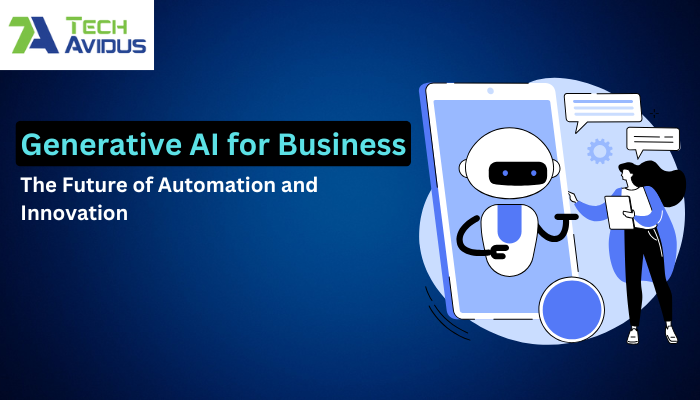The rapid advancements in Artificial Intelligence (AI) are reshaping industries, and Generative AI stands at the forefront of this transformation. From automating content creation to streamlining operations, Generative AI for Business is proving to be a game-changer. But how does it work, and how can businesses harness its power for maximum efficiency and innovation?
What is Generative AI?
Generative AI refers to artificial intelligence models that generate new content—text, images, code, music, and even videos—based on patterns and data it has been trained on. Unlike traditional AI models that analyze and classify data, Generative AI creates something new, making it an essential tool for businesses looking to automate creative and operational processes.
Some of the most well-known Generative AI models include:
- GPT (Generative Pre-trained Transformer): Used for natural language generation.
- DALL·E: Generates realistic images from textual descriptions.
- Codex: Assists in software development by generating code snippets.
- StyleGAN: Creates high-quality images for design and branding.
How Can Generative AI Be Used in Business?
Businesses across various industries are already leveraging Generative AI to enhance productivity, streamline operations, and drive innovation. Some key applications include:
1. Content Generation & Marketing
- AI-powered tools like ChatGPT and Jasper.ai assist in creating high-quality blogs, social media content, and product descriptions.
- Personalized email marketing campaigns driven by AI enhance engagement and conversion rates.
2. Customer Support Automation
- AI chatbots and virtual assistants, powered by NLP models, provide 24/7 customer support.
- Automated query resolution improves customer experience and reduces operational costs.
3. Product Design & Prototyping
- AI can generate product blueprints, design variations, and prototypes, accelerating the R&D process.
- Fashion and interior design industries use AI to create innovative designs based on market trends.
4. Code Generation & Software Development
- AI-powered coding assistants like GitHub Copilot help developers write and debug code faster.
- Automating repetitive coding tasks enhances productivity and efficiency.
5. Data Analysis & Business Intelligence
- AI-driven analytics tools generate insights from vast datasets, enabling data-driven decision-making.
- Predictive analytics helps businesses forecast trends and optimize strategies.
What are the Main Types of Generative AI Models?
Generative AI models vary based on their capabilities and use cases. The main types include:
- Transformer-based models (e.g., GPT, BERT): Focused on text and language generation.
- Generative Adversarial Networks (GANs): Used for image and video generation.
- Variational Autoencoders (VAEs): Applied in image compression and synthesis.
- Diffusion Models: Employed for high-quality image generation (e.g., DALL·E 2, Midjourney).
How to Incorporate Generative AI into Your Business?
To successfully integrate Generative AI into your business, follow these steps:
Step 1: Identify Business Needs
Determine which areas of your business can benefit from AI, such as customer service, content creation, or automation.
Step 2: Choose the Right AI Model
Select a Generative AI model that aligns with your business goals, whether it's text generation, image synthesis, or predictive analytics.
Step 3: Gather and Train Data
For custom AI solutions, collecting relevant business data is crucial to train the model effectively.
Step 4: Implement and Optimize
Integrate AI solutions into your existing workflows and continuously optimize based on performance metrics.
What Tasks is Generative AI Best For?
Generative AI excels in:
- Automating repetitive content creation.
- Enhancing customer engagement through AI-driven personalization.
- Speeding up research and innovation in various industries.
- Optimizing supply chain management with predictive analytics.
- Generating creative assets for marketing and branding.
What is the Main Goal of Generative AI?
The primary goal of Generative AI is to enhance efficiency, creativity, and automation in business processes. By leveraging AI-driven solutions, businesses can reduce costs, increase productivity, and drive innovation without manual intervention.
First Steps to Building a Generative AI Business Solution
- Conduct a feasibility study to understand how AI can benefit your business.
- Develop a proof-of-concept (PoC) to test AI models on small-scale tasks.
- Partner with an experienced AI development company for seamless implementation.
How Generative AI Boosts Business Productivity?
Studies suggest that AI-driven automation can increase productivity by 40% or more. Some major ways AI enhances productivity include:
- Automating tedious and repetitive tasks.
- Reducing errors and enhancing decision-making.
- Optimizing resource allocation and workforce efficiency.
- Streamlining business processes with AI-powered analytics.
Conclusion: The Future of Generative AI in Business
Generative AI is revolutionizing the way businesses operate, offering unprecedented automation and innovation. Whether you're looking to enhance customer experiences, streamline operations, or create new content, Generative AI for Business is an essential investment for future growth.
Why Choose TechAvidus for AI-Powered Business Solutions?
At TechAvidus, we specialize in developing cutting-edge AI solutions tailored to your business needs. Our expert team helps businesses integrate Generative AI seamlessly, ensuring optimal performance and ROI. Ready to transform your business with AI? Contact us here.
